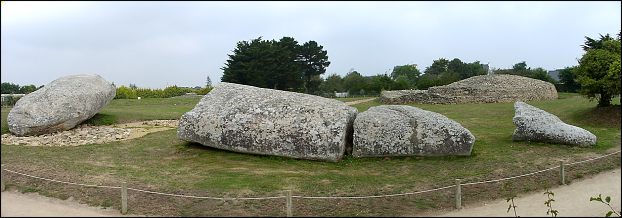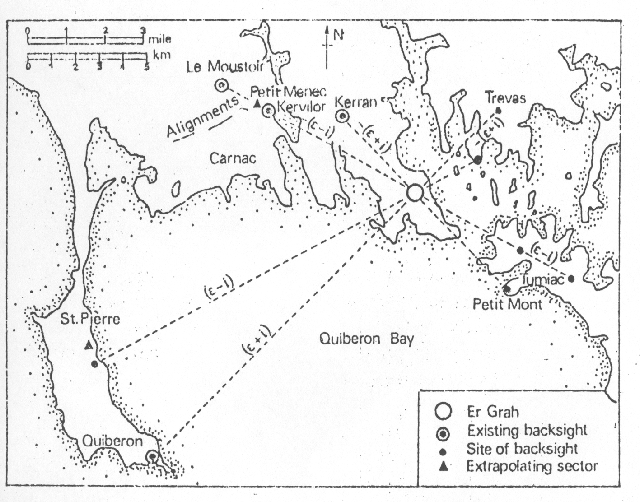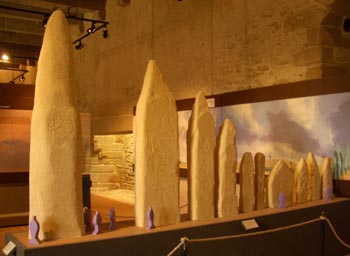Post by brillbilly on Jun 6, 2012 5:30:55 GMT 10
Location: Locmariaquer, Fance. Grid Reference: 47° 35' 45.47" N. 3° 3' 13.57" W
Le Grand Menhir Brisé: (Menhir, Alignment).

This stone has the honour of having once been the largest (known) standing stone in Europe and the largest of a huge 19-stone alignment. Today the menhir is broken into four pieces which still lie where they fell.
Le Grand menhir lies alongside La Table des Marchands passage-mound, and the Er-Grah tumulus, both built at around 3,300 BC, following the destruction of the original alignment, which is now suspected of having been broken up and distributed around the Morbihan area
The Locmariaquer site today:
Le Grand Menhir is one of three structures at the Locmariaquer site. It lies beside the Er-Grah tumulus and the Table des Marchands, both built around 3,300 BC. It is also the last surviving stone of an earlier construction dating from around 4,500 BC (6). The original structure is thought to have been broken around 4000 BC.
Physical description of the stone:

The stone, now fallen into 4 pieces, is estimated to have weighed about 355 tons when complete and to have stood over 20 metres high (an axe-plough figure was once visible on the middle fragment.
John Michell reports the nearest source of similar stone at over 50 miles distance (4), and even though newer reports suggest a distance of only 10km north of Auray (5), it still highlights the fact that the location outweighed the difficulties involved in transporting such large stones over long distances.
The transport of such large stones from such a distance indicates both that the location was important to the builders and that the type of stone was. This same behaviour was repeated at other important megalithic sites such as Stonehenge and Ghiza, where quartz stones were transported over hundreds of miles in order to be used for significant prehistoric structures.
Worked over its entire surface, the monument bears a sculpture representing a "hatchet-plough". Unfortunately today this is seriously eroded and very difficult to see.
When did Le Grand Menhir fall?
John Michell records an Admiralty report of 1659, on a local shipwreck, which noted that:
'la Grande pierre de Locmariaker was visible from the scene of the wreck'.
A Picture by Robien from 1725 shows the stone fallen, which places the time of the fall between 1659 and 1725.
This information ties in with the suggestion that it fell 'during an earthquake in 1722' (2). The way in which the stones landed supports this theory in computer modelling.
What was the original purpose of the site?
The original construction (of which Le Grand Menhir was only a component) was one of Europe's greatest megalithic achievements.
The site was suggested by Prof. A. Thom to have served as a lunar marker, from which it would have been able to calculate the 18.6yr lunar cycle by observing the stone from positions in the surrounding countryside. He predicted the locations of the sites and found ancient markers at several of them, confirming his hypothesis.

Prof. Alexander Thom concluded that it was a huge foresight marker for the moon's rising and setting extremes. He made predictions for the directions of eight observing points, of which six have been shown to still have evidence of prehistoric mounds or stones, one of which is ten miles distant.
Another 18 stones once stood in a line of decreasing height from Le Grande Menhir.

An impression of the design of the original 4,000 BC structure.
www.ancient-wisdom.co.uk/francelegrandmenhir.htm
There's many others too in France!
Le Grand Menhir Brisé: (Menhir, Alignment).

This stone has the honour of having once been the largest (known) standing stone in Europe and the largest of a huge 19-stone alignment. Today the menhir is broken into four pieces which still lie where they fell.
Le Grand menhir lies alongside La Table des Marchands passage-mound, and the Er-Grah tumulus, both built at around 3,300 BC, following the destruction of the original alignment, which is now suspected of having been broken up and distributed around the Morbihan area
The Locmariaquer site today:
Le Grand Menhir is one of three structures at the Locmariaquer site. It lies beside the Er-Grah tumulus and the Table des Marchands, both built around 3,300 BC. It is also the last surviving stone of an earlier construction dating from around 4,500 BC (6). The original structure is thought to have been broken around 4000 BC.
Physical description of the stone:

The stone, now fallen into 4 pieces, is estimated to have weighed about 355 tons when complete and to have stood over 20 metres high (an axe-plough figure was once visible on the middle fragment.
John Michell reports the nearest source of similar stone at over 50 miles distance (4), and even though newer reports suggest a distance of only 10km north of Auray (5), it still highlights the fact that the location outweighed the difficulties involved in transporting such large stones over long distances.
The transport of such large stones from such a distance indicates both that the location was important to the builders and that the type of stone was. This same behaviour was repeated at other important megalithic sites such as Stonehenge and Ghiza, where quartz stones were transported over hundreds of miles in order to be used for significant prehistoric structures.
Worked over its entire surface, the monument bears a sculpture representing a "hatchet-plough". Unfortunately today this is seriously eroded and very difficult to see.
When did Le Grand Menhir fall?
John Michell records an Admiralty report of 1659, on a local shipwreck, which noted that:
'la Grande pierre de Locmariaker was visible from the scene of the wreck'.
A Picture by Robien from 1725 shows the stone fallen, which places the time of the fall between 1659 and 1725.
This information ties in with the suggestion that it fell 'during an earthquake in 1722' (2). The way in which the stones landed supports this theory in computer modelling.
What was the original purpose of the site?
The original construction (of which Le Grand Menhir was only a component) was one of Europe's greatest megalithic achievements.
The site was suggested by Prof. A. Thom to have served as a lunar marker, from which it would have been able to calculate the 18.6yr lunar cycle by observing the stone from positions in the surrounding countryside. He predicted the locations of the sites and found ancient markers at several of them, confirming his hypothesis.

Prof. Alexander Thom concluded that it was a huge foresight marker for the moon's rising and setting extremes. He made predictions for the directions of eight observing points, of which six have been shown to still have evidence of prehistoric mounds or stones, one of which is ten miles distant.
Another 18 stones once stood in a line of decreasing height from Le Grande Menhir.

An impression of the design of the original 4,000 BC structure.
www.ancient-wisdom.co.uk/francelegrandmenhir.htm
There's many others too in France!






 Happy New Years Everybody!!!
Happy New Years Everybody!!!
